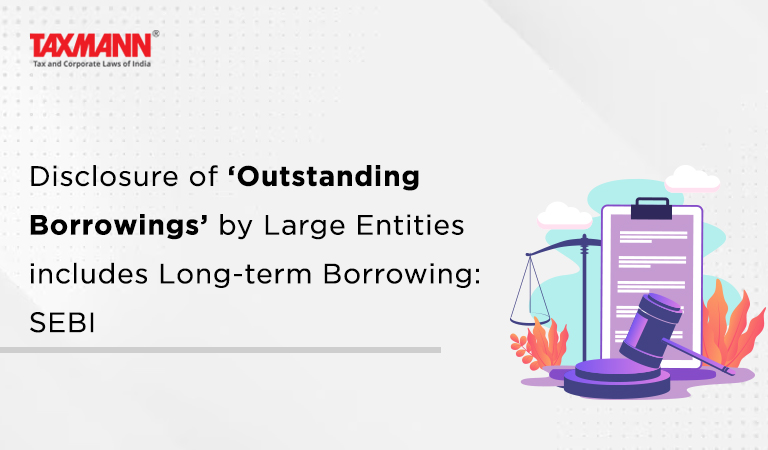Disclosure of ‘Outstanding Borrowings’ by Large Entities includes Long-term Borrowing: SEBI
- Blog|News|Company Law|
- 3 Min Read
- By Taxmann
- |
- Last Updated on 22 April, 2023
Informal Guidance No. SEBIIHO/DDHSIDDHS-P001/P/OW/2023/15712/1, dated 19.04.2023
The SEBI, in its reply to an informal Guidance sought by Eris Lifesciences Limited, has stated that outstanding long-term borrowings shall mean any outstanding borrowing with an original maturity of more than one year, except ECB and inter- corporate loans.
Query raised by the Applicant Company
The Applicant Company sought informal guidance on whether the term “outstanding borrowing” as specified in the Circular titled ‘Operational Circular for the issue and listing of Non-convertible Securities, Securitised Debt Instruments, Security Receipts, Municipal Debt Securities and Commercial Paper’ dated August 10, 2021 should be construed to mean only outstanding borrowings.
Also whether this would include borrowings that are simultaneously long-term, unsupported and attracting credit rating requirements, as per the circular.
Main Concern of the Applicant Company
The Company stated that it would have borrowings of Rs 100 crores or above at the end of March 31, 2023. However, each of those borrowings shall either be:
(a) Other than long-term borrowings. For instance, a working capital loan facility which is availed and repaid as needed over the tenure of such facility; or
(b) Duly supported by the creation of suitable charges or other encumbrances over the assets of the listed entity for securing the repayment of principle and interest availed under the long-term borrowing.
Provisions specified in Para 3 of Chapter XII of the Operational Circular
Para 3 of Chapter XII of the Operational Circular dated August 10, 2021 specified the disclosure requirements for large entities. As per para 3 of the operational circular, a listed entity identified as a Large Corporate (LC) is required to make applicable disclosures certified by both CFO and CS of the Company within the prescribed time limits and in the prescribed formats.
Each of these disclosure forms uses the word ‘borrowing’ in an unrestricted and unqualified manner i.e. without stipulating that only those borrowing that are unsecured, long term and attracting rating requirements needed to be considered for the purpose of making entries in those forms.
The SEBI’s observations
SEBI was of the view that the framework provided in Chapter XII of the Operational Circular pertaining to the mandatory requirement of the raising of a minimum of 25% of the incremental borrowing through issuance of debt securities shall be applicable to the following:
(a) All entities that have their specified securities or debt securities or non-convertible redeemable preference shares, listed on a recognised stock exchange(s) in terms of SEBI (LODR) Regulations, 2015;
(b) All listed entities that have an outstanding long-term borrowing of Rs 100 crore or above, where outstanding long-term borrowings shall mean any outstanding borrowing with an original maturity of more than one year and shall exclude external commercial borrowings and inter-corporate borrowings between a parent and subsidiary(ies); and
(c) All listed entities have a credit rating of “AA and above” where the credit rating shall be of the unsupported bank borrowing or plain vanilla bonds of an entity, which have no structuring/support built and in case, where an issuer has multiple ratings from multiple rating agencies, the highest of such ratings shall be considered.
(d) The applicability of the framework to the listed entities shall be determined on the last day of the financial year (i.e. March 31 or December 31).
SEBI reply
In response to the query, the SEBI clarified that outstanding long-term borrowings should not only be construed as only those borrowings which are simultaneously long-term, unsupported and attracting credit rating requirements, as per the circular.
‘Outstanding long-term borrowings’ shall mean any outstanding borrowings with an original maturity of more than one year, except ECB and inter- corporate loans.
Click Here To Read The Full Guidance
Disclaimer: The content/information published on the website is only for general information of the user and shall not be construed as legal advice. While the Taxmann has exercised reasonable efforts to ensure the veracity of information/content published, Taxmann shall be under no liability in any manner whatsoever for incorrect information, if any.

Taxmann Publications has a dedicated in-house Research & Editorial Team. This team consists of a team of Chartered Accountants, Company Secretaries, and Lawyers. This team works under the guidance and supervision of editor-in-chief Mr Rakesh Bhargava.
The Research and Editorial Team is responsible for developing reliable and accurate content for the readers. The team follows the six-sigma approach to achieve the benchmark of zero error in its publications and research platforms. The team ensures that the following publication guidelines are thoroughly followed while developing the content:
- The statutory material is obtained only from the authorized and reliable sources
- All the latest developments in the judicial and legislative fields are covered
- Prepare the analytical write-ups on current, controversial, and important issues to help the readers to understand the concept and its implications
- Every content published by Taxmann is complete, accurate and lucid
- All evidence-based statements are supported with proper reference to Section, Circular No., Notification No. or citations
- The golden rules of grammar, style and consistency are thoroughly followed
- Font and size that’s easy to read and remain consistent across all imprint and digital publications are applied






 CA | CS | CMA
CA | CS | CMA


